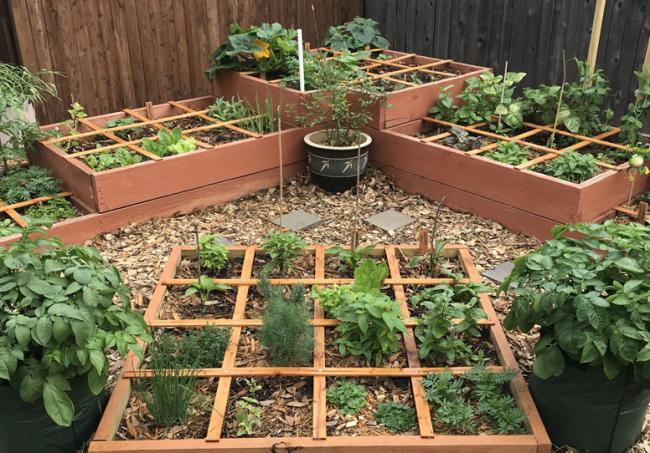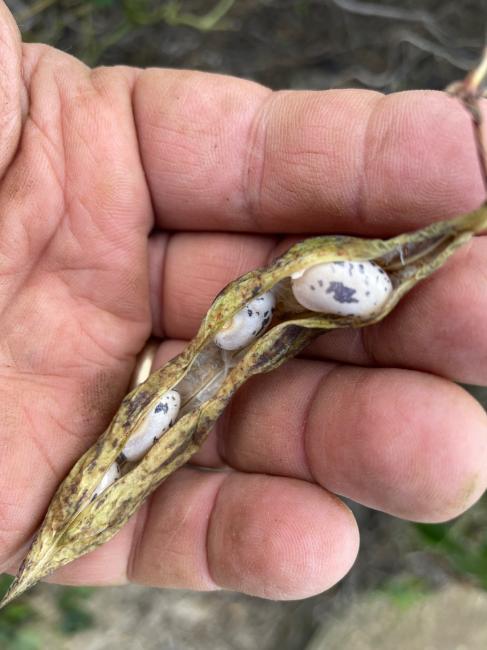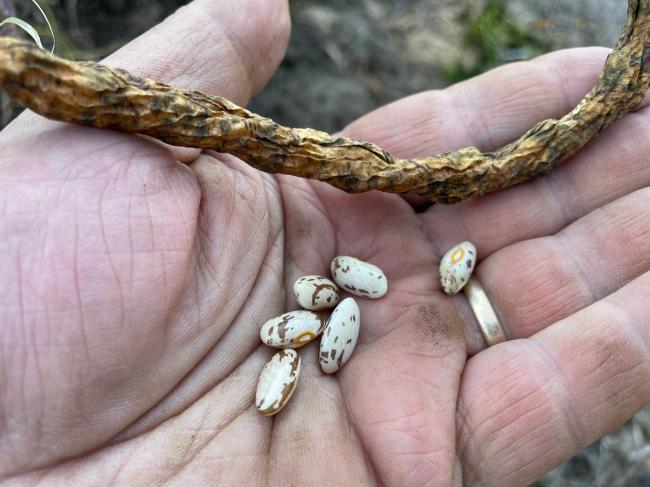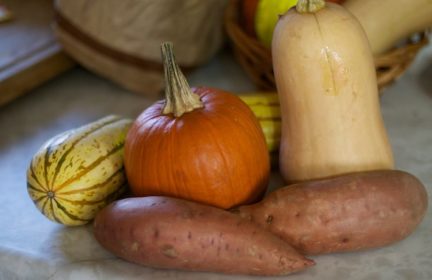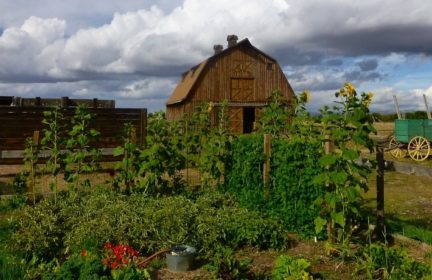Changing how and what vegetables I’m growing next year
My allotment was vandalised a couple of weeks ago. They smashed my winter squash and the shelling beans were strewn hither and yon, winter greens were pulled up and the little store box was set alight. I’m done with it. Add to that a Rabbit infestation that the council are not keen to deal with, I have decided to give up the allotment and make more of the space I have at home. Our yard is small, barely 30′ x 18′. Half of the yard is spoken for, so that leave me a space 8′ x 20′. I have worked out that will give me 4 4’x8′ raised beds. I was surprised how much space there actually was. I have used the raised bed method before, with great success so with careful choice of vegetable types and varieties, I am looking forward to growing a substantial amount of our vegetables (we are a family of 2).
I’m going to incorporate the square foot growing method as well as catch cropping and anything else I can think of.
This garden probably won’t provide sufficient produce for preserving for the winter, but I hope with judicious planting to have enough space to keep a winter garden as well as the flourishing summer garden.
I hope to keep you appraised so that those who have little space and experience can hopefully learn something from my experiences.
So watch this space!
-
Comments (31)
-
RedneckContributor - November 4, 2021
I’m not familiar with the growing methods you mentioned. I suggest growing vertical as much as possible, using trellises. I get a tremendous amount of pole beans in an area 4′ x 8′. Also try to use any existing fencing or side of the house for things to grow on. With proper planning, you can get three separate crops in each bed… spring plants, summer plants & fall plants.
-
JennyWren - November 4, 2021
The yard is walled, so there is plenty of vertical space and I’m planning on maximising this.
Pole beans are high on the list
-
-
Illini Warrior - November 4, 2021
ditto on the vertical – both sides with an inter-mix of trellised veggies >>> you’d be surprised how well pole beans will climb with trellis hung tomatoes ….
-
Barb LeeContributor - November 4, 2021
JennyWren, I am just writing to say how saddened I am to read of this senseless act of vandalism and hope that you recover quickly from the shock of the loss. I am so glad you have a protected space to call your own and I know that your quest for innovative growing methods will be rewarded.
-
JennyWren - November 4, 2021
Thanks Dogpatch. It’s the waste of food the riles me. They went through the allotment field and hit a number of us, so I’m not alone. Just glad I was experimenting and not relying on that crop.
Onward and upward!
-
-
Robert LarsonContributor - November 4, 2021
Darn punks! I am sorry they destroyed all your hard work.
I hope your future garden goes well and is nice for you.
Redneck – I have heard about square foot gardening in the past, but didn’t know much about it either. If she is doing what I just looked up about it, it is dividing up your raised bed into 1X1 grids and planting different things in each square. It give people a lot of diversity and simplicity who are tight on space. According to squarefootgardening.org it “costs 50% less, uses 20% less space, 10% of the water, and only 2% of the work compared to single row gardening.”
-
Robert LarsonContributor - November 4, 2021
The more I look into it, the more I am interested in trying this method out as well this next year.
-
RedneckContributor - November 4, 2021
Sorry but it seems silly to me. Why all the extra wood in the bed? What happens in those little squares when the plant becomes 3 feet tall & 3 feet wide? Also many garden plants don’t grow straight up. It is very common for them to lean over. A mature, bearing garden doesn’t necessarily look real pretty & organized.
To me, the point in raised bed gardening is to utilize all available space and to do so for the entire growing season. To do so, one needs to be flexible and not be constrained by little planting areas. Different garden plants require different amounts of space. Some plants like to be crowded… others don’t. Some can handle some shading… others like full sun. Also, you need to rotate the planting, so that you don’t plant the same crop in the same location each year.
I subscribe to KISS… keep it simple stupid. And my garden never looks so neat & pretty. I have plants falling over. I have pumpkin vines spreading out beyond their bed & in the walkways. They also are growing up & over the back fence & into the dog yard. I have tomatoes growing in the aisle after spilling out of their raised bed. I have basil plants mixed in with my pepper plants so that you can no longer see the peppers were planted in rows. I have muscadine vines growing on a tension wire above the fence. Once again, not neat & pretty but it is productive & flexible.
If you want your plants 1′ apart, then just use a tape measure & plant them that way. You don’t need a wooden box to do that. Want your plants all neat & in a straight row, just tap in a couple of nails & run a string.
-
Robert LarsonContributor - November 4, 2021
I showed that picture of a square foot garden to my wife and she thought the wood inside was a bit much too. To be fair, I think it’s mostly there for looks and to demonstrate the concept and isn’t necessary. Just plant things 1′ apart like you said.
She also wondered what vegetables like pumpkins and zucchini did when they out grew their square.
I think the square foot gardening could be valuable for some crops like strawberries, carrots, or lettuce, but not ideal for others like pumpkin or corn.
-
RedneckContributor - November 4, 2021
If you think about it, aisles are a waste of space… especially if you garden area is small. So I plan on certain plants to escape the bed & produce in the aisles. You can plant some tomato plants, for example, and then put some pumpkins in front of them. The roots will be in the raised bed but the majority of the growth will be in the aisle. Kinda makes it fun to figure out where to put your feet sometimes, but the tradeoff is more food production & better utilization of space.
Many folks would say don’t plant corn in such a small garden, but I’d certainly grow some. I just find it cool to watch corn grow & I certainly love the harvest. Might not be the best use of limited space but growing it feeds my soul. You can also use the corn as a free trellis to grow your pole beans.
-
Robert LarsonContributor - November 4, 2021
The newbie gardener might not know what a pumpkin or tomato plant will look like when it is fully grown, so you bring up a good point of knowing that before you grow so you can grow close together and maximize space.
-
Valerama - November 7, 2021
I’ve done square foot gardening for more than 20 years; I started without raised beds and later chose to use them mostly because it was easier to maintain the paths between them and keep the weeds out. Raised beds certainly aren’t required.
In my opinion it’s less daunting to weed a 4’x4′ box than larger areas. Easier to water, too, though since I’ve moved to coastal Virginia I don’t worry about it so much as I rarely have to break out the hose. It is also easier to do successive plantings for the amount of certain things so you aren’t harvesting everything at once.
If you’ve got the space for traditional gardening, and have a plan for preserving excess, I agree that is a sound plan. But for small areas SFG is a sound plan that has been around since the early 1980s.
-
Robert LarsonContributor - November 7, 2021
What are some of the things you have grown in your SFG?
Are there some plants that you tried but learned that they don’t fit the SFG method?
-
Valerama - November 8, 2021
I’ve done a wide variety of lettuces and other greens. Beets, radishes, turnips, both bush beans and pole beans, peas, strawberries, onions, tomatoes, tomatillos, potatoes garlic, leeks, herbs, zucchini, acorn squash, cucumbers, various gourds.
Climbing things do well. I prefer cattle panels mounted vertically to electrical conduit frames. (winter squash, cucumbers, tomatoes, peas, beans)
Asparagus don’t do well, sprawling plants that don’t train vertically well don’t either. Potatoes, I’ve decided it’s not a good use of the space in the squares. My preference is quick harvest products. The benefit is turning those squares over or things with an extended harvest season.
-
Robert LarsonContributor - November 8, 2021
Thanks for letting me know about the variety of things you have grown and what hasn’t worked as well for this way of gardening. I agree that potatoes probably aren’t as good for this method.
I’ve never have grown or cooked with leeks before, that’s another veggie I want to look into.
-
JennyWren - November 9, 2021
Thanks very much for this information Valerama. I had pretty much decided on what to grow, and your experiences have confirmed my ideas,
Have you ever tried Potato towers? I use this method and for maincrop potatoes I have been very successful.
-
-
JennyWren - November 5, 2021
A lot also depends on what variety you grow, which again a new gardener may not know. The man of the house is going to put up some support wires on the back wall, which is 12′ high and gets a lot of sun. I’m thinking the winter squash would do really well growing vertically up it, though I may need a ladder for harvest time.
I have an online friend who uses the square foot method and he uses twine to mark out the squares The thing that attracted me to it once a square is empty it can be filled straight away so (to my mind) will make the bed more productive. I’ll use one bed for this method and see how it goes.
-
Illini Warrior - November 5, 2021
I like the mix of open bed garden and the smaller raised beds >>> if nothing else the raised beds can be used as an early spring hot house – the side rails can be fitted with “hoop” brackets – poly sheet stretched over – just set your seeded pots or trays inside – secondary benefit is to warm up that plot of ground for early planting ….
-
Oldprepper - November 10, 2021
Jennywren
I am not a gardener but have recently been doing research into growing produce because I find it a necessary evil and logical to prep. There is also a guy in here that motivated me through his posts!
I have this last month started growing produce from seeds of fruits and vegetables bought from the local store. I use this method because in times of crisis what you have available is what you will have to work from, so…… bought seeds are out for me!
The soil I have to work with is really bad…..so I looked at alternate methods and found Hydroponics which although I understood the principle though never investigated …. I see that for preppers (and maybe civilization) could be the only way forward!
I was absolutely amazed at the amount of people growing produce in very small apartments using the Kratky method which is extremely simple and is perfect for a lazy gardener like me ………who always has limited time but want to be self sufficient.
There are others who have outdoor space no bigger than yours that are growing fruit and vegetables for families much bigger than yours ………………..do it very easily and have been for years.
I do not know if my efforts will pay off, but I am really optimistic given that everything I have planted has started to grow…….. with no soil! ………..Onions, potato,strawberries, tomato, peppers are all looking good…. small and a way to go yet……..but looking good so far!
There are companies that produce ready made containers for hydroponics that measure 8ft x 20ft and can feed fresh produce to 100 people on a regular basis with little problem ….very cheaply.
I am not suggesting you buy one…. just demonstrating that your area is actually a lot bigger than you would suppose! and a lot easier to keep an eye on than destructive people on your allotment!
-
RedneckContributor - November 10, 2021
Glad to see you are starting the journey into growing some of your food. I think you will find it very rewarding.
I want to make sure you understand when you grow from seed saved from store bought produce, you never know what you will get. It is a good chance it will be rather different from what you ate. Most of the food in stores is a hybrid, and they don’t breed true. You could also have something that was crosspollinated in the field, and that also will give different results.
I do suggest you purchase open pollinated seed. That way you know what you will get & what you will get forever, as long as you don’t allow it to crosspollinate. That is the only seed I buy. That allows me to save the seed for next year & know what I will be getting.
-
Oldprepper - November 10, 2021
Redneck
So if I bought a pack or two they would last a long time?
Can I then seed off those seeds?
Thanks for the advice…….. see I am learning something new!
-
RedneckContributor - November 10, 2021
If your seeds are nice & dry, as commercial seeds will be, you can freeze them & they will stay viable for many years. Otherwise if kept dry & cool, they will generally last a few years.
Not sure what you mean by seed off those seeds. But if you grow those seeds & harvest the fruits, then yes you can save those seeds & they will breed true… assuming you got open pollinated varieties. That is what I’m doing with my Rattlesnake pole beans now. I’ve allowed the pods to stay on the vines & dry naturally. I’ll put the dried beans (seed) in a container in my refrigerator & plant next year and they will be the same Rattlesnake pole bean. Excess dried beans will be cooked for dinner. Hard to imagine those dried pods were recently succulent, green beans that we were eating for dinner.
-
JennyWren - November 10, 2021
Thanks for the ideas for hydroponics and it’s something I did look at sometime ago, but rejected it due to cast. The Kratky method looks good for quick crops so might try a bucket and see what happens.
I would echo what Redneck said about seeds.
-
Oldprepper - November 10, 2021
But dont pay too much attention to my thoughts… I am a newbie….. to gardening!
-
RedneckContributor - November 10, 2021
Hey, us old dogs can still learn new tricks. 🙂
-
JennyWren - November 10, 2021
Yep there’s always something to learn!
-
CR - November 11, 2021
Oldprepper, I agree with Redneck’s advice on open pollinated or Heirloom seeds, as they will give the same crop year to year from saved seed. I’ve had old tomato seeds from seven years ago be perfectly viable, room temperature stored. Now I keep my long term seed packets in mason jars in a deep freeze. Should really last well like that. When using from that storage tho, it’s best to thaw slowly in fridge, from what I read, and only thaw what you’re going to plant right away.
Also, buy from good reputable sources that verify their germination rates: grow organic.com, Nichols seeds, Park Seed from South Carolina…Seed companies can vary quite a lot in quality and there’s no sense in storing poor quality to depend upon in a crisis.
-
Oldprepper - November 11, 2021
CR
Thanks for the info……
Gonna be in the US early next year…. and gonna get a good stock I think.
Good advice!
-
-
brekke - November 10, 2021
So sorry about your garden getting vandalized! I’m excited to read about your transition to the new space and different methods. We had our first outdoor garden this last year and my husband really enjoyed it. We have so much to learn though and only a few of our items produced properly. Our green beans, snow peas, spinach and leafy greens one blueberry bush did great, but our potatoes, tomatoes, strawberries, raspberries and celery failed. The carrots, pumpkins and cucumbers produced a few, but not nearly as many as we planted. And the blackberries were planted too late to produce a crop
We’re starting a small hydroponics garden inside this week with hopes of continuous salad greens and spinach to start. We’re hoping to learn about the process through the commercial garden and then expand it using DIY options in the future. I’m also (slowly) researching ways to grow potatoes inside as they are a large diet staple for our family.
Last year we planted two apple trees, a plum tree, and two blueberry bushes. We got a couple of plums and apples and a bowl full of blueberries. We’re going to expand the number of blueberry bushes in the spring and build a couple of large trellises for our raspberries and blackberries to hopefully thrive on. Most people try to kill blackberries around here, but my MIL makes some excellent blackberry jam that I’m hoping she can teach me.
-
JennyWren - November 10, 2021
I have had great success with Potato Towers as in this youtube video. This is by no means the only video out there, so I would check them out. When I fill mine, I insert a drainpipe with holes drilled into it to get water and liquid feed all the way down the tower. Remember not to fill it to the top as once the potatoes start to form, you will need room to top up the soil as they start to push up. They are a great way to cheaply grow a lot of maincrop potatoes in a small space.
-
brekke - November 11, 2021
I will definitely check that out. Thank you!!
-
-
- Has anybody blood tested the Oroweat keto tortillas? - 4 days ago
- News for the Week 2024-04-22 - 4 days ago
- News for the Week 2024-04-15 - 5 days ago
- What is the best camp stove for an emergency power outage or camping? - 7 days ago
- Chickens for preppers: Important considerations - 1 week ago
This forum is heavily moderated to keep things valuable to as many people as possible. Full community policies are here. The basics:
- 1. Be nice to each other.
- 2. Stay focused on prepping.
- 3. Avoid politics, religion, and other arguments.
- 4. No unfounded conspiracies, fake news, etc.
- 5. Debate ideas, not people.
